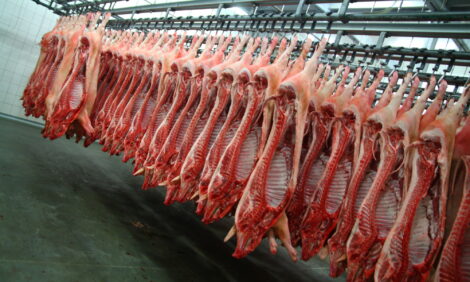



World Pork Trade Overview - March 2003
By USDA Foreign Agricultural Service - This article provides an overview of global pork trade predictions for 2003. The report covers the US, Brazil, Canada, EU, Hong Kong, Japan, Mexico and Russia. The report concludes that with the deceleration in global pork trade, U.S. exports are expected to grow slowly in 2003.World Summary:
Trade policy will dictate the tone of 2003 global pork trade.The Russian tariff rate quota (TRQ) announced on January 23, 2003, is expected to limit Russian pork imports to 630,000 tons, a 21-percent decline from the 2002 import level.
Japanese import growth will slow to an estimated 1 percent as beef consumption continues to recover from BSE concerns.
Mexican pork imports are forecast unchanged from 2003.
The combined effect of these measures suggests greater competition among the world’s leading pork exporters.
Key Exporters:
United States:
U.S. pork production is forecast to decline in the second half of 2003 as producers respond to poor profitability. Despite lower U.S. production, exports are expected to grow by almost 2 percent in 2003.The impact of the Russian TRQ will be mostly indirect, as the Russian market accounted for less than 3 percent of U.S. pork exports in 2002.
Mexico’s anti-dumping investigation casts a cloud on the forecast for U.S. pork exports, however, interested groups, both in the U.S. and in Mexico, appear determined to find a resolution that will preserve the successes of the NAFTA framework. Mexico accounted for 21 percent of U.S. pork exports in 2002. While trade with Mexico and Russia appears to have slowed, demand for U.S. pork in Korea is expected to remain relatively strong.
Japan continues to be the largest market for U.S. pork, accounting for 48 percent of U.S. exports.
Brazil:
After extraordinary growth in the last two years, Brazilian pork production is expected to slow in 2003, as relatively high feed costs and low pork prices are likely to trim profits for many hog producers. Brazil’s exports for 2003 are forecast to contract by 15 percent from 2002 levels. Russia, which alone accounts for almost 80 percent of Brazilian pork exports, will be a very difficult market given the TRQ situation and Russia’s ongoing sanitary concerns with Brazilian pork. However, Brazil is expected to actively seek alternative markets to offset any losses in Russia.Canada:
Canadian hog inventories are still growing. The Statistics Canada estimates for January 1, 2003, show a 2.5 percent increase in the hog inventory, and a 3 percent increase in breeding stock numbers. Canadian pork exports are forecast to remain strong, growing by over 4 percent in 2003 and representing 47 percent of production. Although the United States will remain the most important destination for Canadian pork, accounting for almost 60 percent of exports, Canada is expected to increase exports to other markets as well. Exports to Australia and Korea have been increasing, and Mexico remains a major market for Canadian pork.European Union:
The 2003 EU pig crop is forecast to decline slightly as the Netherlands and Belgium continue to face environmental constraints, and the United Kingdom tackles a feeder pig shortage and problems with sow infertility. While sow stocks in Germany, Denmark and France appear stable, expanding pork production in Spain is expected to largely offset declines elsewhere in the EU. The EU pork export forecast for 2003 has been revised downward to account for the impact of the Russian TRQ. Russia is the EU’s second largest market, accounting for more than 15 percent of total exports. Elsewhere, the EU is forecast to remain very competitive.Key Importers:
United States:
U.S. pork imports in 2002 grew nearly 13 percent from 2001 levels. For 2003, pork imports are forecast at 490,000 tons, up less than 1 percent from 2002. Canada continues to be the most dominant foreign supplier, accounting for about 80 percent of U.S. pork imports. The U.S. and Canadian markets are also increasingly integrated in the movement of live animals. In 2003, the U.S. is expected to import close to 5.8 million live hogs, an estimated 69 percent of which will be feeder pigs. The EU is still in the process of regaining some of its pre-FMD share of the U.S. pork market. The Country-of-Origin-Labeling (COOL) provision, mandated under the U.S. Farm Security and Rural Investment Act of 2002, has been causing concerns among U.S. trading partners. For further COOL information, please refer to the following internet website: http://www.ams.usda.gov/cool/Hong Kong:
Pork imports for 2003 are forecast at a record 280,000 tons, up 2 percent from the 2002 level. A sluggish economy, higher unemployment rate, and a recurrence of an avian disease outbreak in Hong Kong are causing consumers to switch to pork from other meats. In addition, consumer preferences are changing from freshly slaughtered meats to chilled/frozen meats due to gradual changes in eating habits and concern over sanitary conditions in the wet market. Pork imports from China continue to increase as the Chinese government now allows more than one agent to market its meat in Hong Kong. In 2002, China, Brazil and the EU were Hong Kong’s main pork suppliers.Japan:
Pork production has been steadily declining due to the shrinking number of swine producers. Between 1992 and 2001, the number of hog producers dropped 33 percent. During the same time frame, as pork production fell 13 percent, consumption grew by almost 9 percent. For 2003, imports are forecast to increase by about 1 percent. The imposition of a safeguard tariff in August 2002, lasting through March 31, 2003, seems to be having little effect. In 2002, pork imports grew by more than 8 percent over the previous year. The safeguard raises the minimum price at which foreign pork can be imported into Japan, making imported pork less competitive vis-à-vis domestic products. Although the safeguard typically lowers demand for all imported pork, demand for frozen products tends to decline the most. Under the safeguard, imported fresh pork, which typically benefits from larger profit margins, but has a more limited shelf life, continues to be in relatively high demand. The United States is the largest foreign supplier to the Japanese market, followed closely by Denmark, Canada and Mexico.Mexico:
After a record year in 2002, Mexican pork imports are expected to remain level in 2003. NAFTA provisions eliminated import tariffs and TRQs on pork on January 1, 2003, but mounting pressure from Mexican hog farmers triggered an anti-dumping investigation on U.S. pork. Despite lingering uncertainty over the final outcome, producers on both sides are working toward an amicable resolution. The U.S. accounted for 84 percent of Mexican imports in 2002. Canada and Chile supplied the balance. Prior to January 1, 2003, Canada had been constrained by a NAFTA TRQ level much lower than the one facing the United States. With the elimination of TRQs, Canada is expected to become more competitive in the Mexican market.Russia:
Russia has introduced a 450,000-ton TRQ for pork under HS code 0203 (fresh and frozen pork). The intended aim of the TRQ is to boost Russia’s domestic production, decreasing its dependence on pork imports. Production is expected to increase 7 percent in 2003. Under the TRQ, the 2003 forecast estimates a 21-percent reduction in total pork imports. While not country specific, the TRQ is expected to mostly affect the largest exporters to the Russian market: Brazil, the EU and, to a lesser extent, China. In 2002, Russia imported 800,000 tons, an estimated 33 percent of total pork consumption.Source: USDA FAS - March 2002








